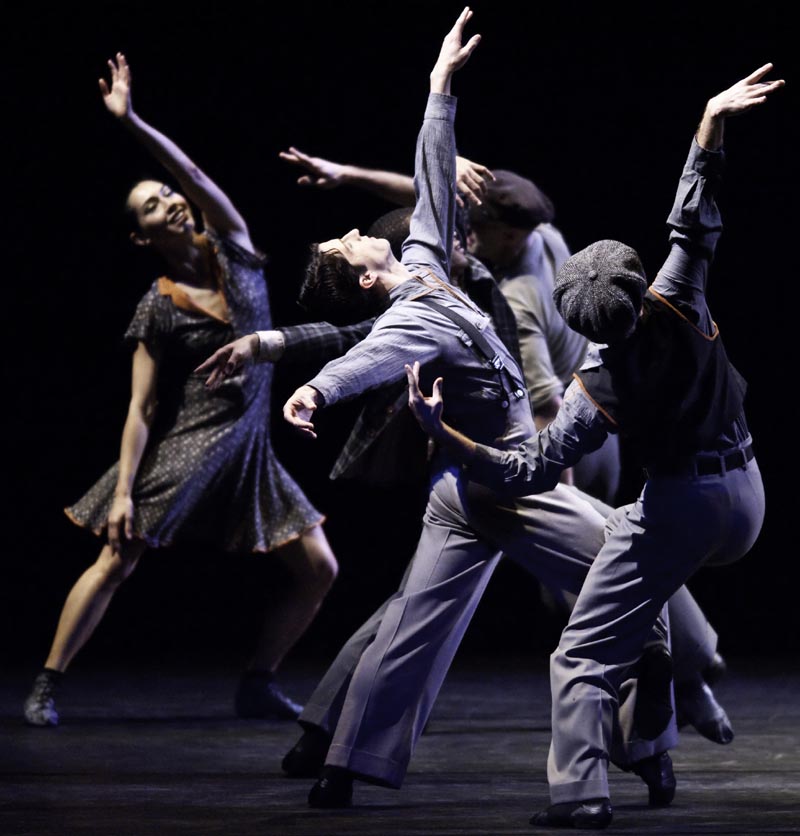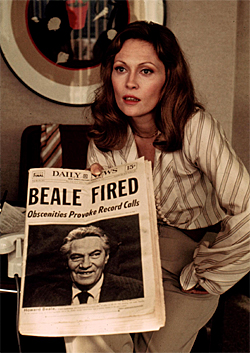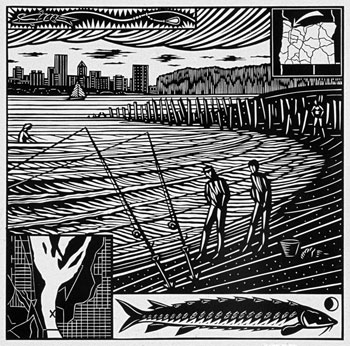 Art Scatter is looking over at Portland Arts Watch and saying, hey man, what about me. Over there, I’ve been posting madly the past couple of days, and of course I’m going to tell you all about it, right now!
Art Scatter is looking over at Portland Arts Watch and saying, hey man, what about me. Over there, I’ve been posting madly the past couple of days, and of course I’m going to tell you all about it, right now!
I’ve had a couple of posts on the PNCA-Museum of Contemporary Craft merger. The first was a column for The Oregonian, arguing that Portland’s thriving design community was at the heart of it; the second, a further cogitation, having chatted with craft artist/printmaker/you name it Frank Boyden, a longtime member of the Contemporary Crafts Community. Then, I had a few observations about the Lar Lubovitch Dance Company visit on Wednesday; people love their classical modern dance. And last night I went to hear Nobel economist Paul Krugman (though I could just as easily gone to Cornell West, and I’m in a cognitively dissonant state over my choice even as I type). He had some direly smart things to say.
So, if any of those strike your fancy, please link up. Portland Arts Watch needs your minds working on these topics!
I will say that a lot of my thinking these days has been guided by the post on Anne Focke’s essay, right below this one, and it will turn up in my Monday column for The Oregonian, which is about the instability of “purist” arts institutions in our hybrid world. Well, it’s sort of about that, anyway, and suggests that new models, such as Classical Revolution PDX and Portland Cello Project, might be in the offing. It also has an interview with double-bass genius Edgar Meyer!
Meyer was pretty distracted for our conversation. He’d played like an angel the night before with the symphony, but he had something else on his mind when we sat down, namely a recording session with his old friend Bela Fleck, who has done for the banjo much of what Meyer had done for the bass, and Zakir Hussain, the tablas giant. Well, that’s newspaper talk. Is he actually a giant? Probably not. And Meyer’s not the most loquacious fellow to begin with, at least not with miserable minions of the press. But it was still great to talk to him, because what he did say was entirely pertinent. Succinct but pertinent, with traces of his Tennessee accent.
After I talked to Meyer, I made a point last weekend of seeing Third Angle’s minimalism show (I know. I posted on that at Portland Arts Watch, too), the Superman Orchestra (which involved Mattie Kaiser and some Classical Revolution musicians) and then some Cello Project folks at Doug Fir with choirs, Irish folk provocateurs, folkies, etc., all culminating in “Carmina burana.” Mercy! I wrote about that stuff over there, too. All of which made me think that this whole musical “purism” argument wasn’t just losing — it had already lost. The world has changed, and you can stay in your bunker with your tricked out sound system and the perfect acoustical set-up and listen ONLY to Bach or hard bop or Janis Joplin, but you’re missing out on a lot of interesting music. I’m imagining those Japanese soldiers, left on remote islands, who hid in the jungle and then stumbled into some village in the 1960s and were amazed to find out that the was over — and, by the way, they lost. Bummer. I know that Art Scatter readers are profoundly post-modern, though!
So, yeah, busy. And did something happen with Sam Adams? Honestly, we’re not going to get into THAT here. Maybe Bob will turn his analytical high-beams on the situation at some point, but I’m waiting for the passion to settle and a few thoughts to bubble up. Because really, the issues involved ARE interesting and it’s one of those rare opportunities to get a fix on where the collective mind is, for example, on our sexual norms. (I’ve already heard two perfectly reasonable people say that kissing is, or at least can be, sex. I didn’t know that — I was a lot busier in high school than I thought!)
 This phalanx of Art Scatter has been totally missing for a while. Quite a while. Which means we’ve been posting our fool heads off at Portland Arts Watch, trying to get that vessel seaworthy.
This phalanx of Art Scatter has been totally missing for a while. Quite a while. Which means we’ve been posting our fool heads off at Portland Arts Watch, trying to get that vessel seaworthy.  Everyone knows that this an era of shrinking resources at your local newsgathering operation (which we once called a “newspaper”). That means fewer staff members and less space in the paper for just about every section and department. And that in turn means a reconsideration of almost all of the coverage habits that have been developed over the decades.
Everyone knows that this an era of shrinking resources at your local newsgathering operation (which we once called a “newspaper”). That means fewer staff members and less space in the paper for just about every section and department. And that in turn means a reconsideration of almost all of the coverage habits that have been developed over the decades. So last night, after the Super Bowl, I was channel-surfing. I’m not proud of it, but there you have it. Sometimes I think that’s the way the universe is trying to talk to me: If I happen upon the “Dog Whisperer,” I might conclude that I’m not calm and assertive enough (or maybe not submissive enough? Sometimes I get mixed messages). If “Ask This Old House” is working on someone’s water heater, then I immediately suspect that mine needs some lovin’.
So last night, after the Super Bowl, I was channel-surfing. I’m not proud of it, but there you have it. Sometimes I think that’s the way the universe is trying to talk to me: If I happen upon the “Dog Whisperer,” I might conclude that I’m not calm and assertive enough (or maybe not submissive enough? Sometimes I get mixed messages). If “Ask This Old House” is working on someone’s water heater, then I immediately suspect that mine needs some lovin’.  Art Scatter is looking over at Portland Arts Watch and saying, hey man, what about me. Over there, I’ve been posting madly the past couple of days, and of course I’m going to tell you all about it, right now!
Art Scatter is looking over at Portland Arts Watch and saying, hey man, what about me. Over there, I’ve been posting madly the past couple of days, and of course I’m going to tell you all about it, right now! OK, this one’s a little long, but it tries to get at some important issues of how we organize ourselves, operate in the world, through the lens of two “artist managers,” Seattle’s Anne Focke and the late Joel Weinstein.
OK, this one’s a little long, but it tries to get at some important issues of how we organize ourselves, operate in the world, through the lens of two “artist managers,” Seattle’s Anne Focke and the late Joel Weinstein.



